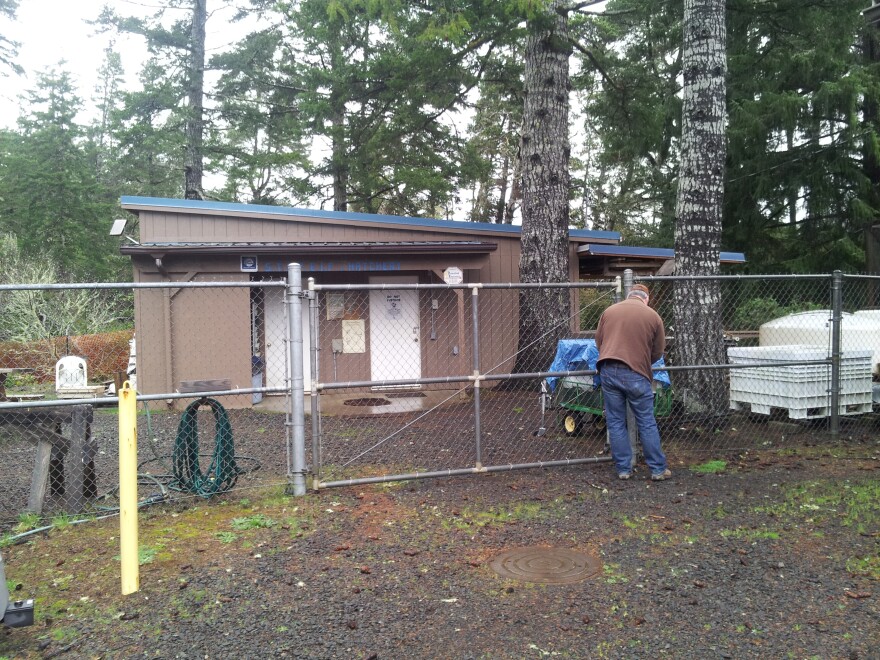A volunteer-run fish conservation group in Florence is shifting focus nearly two months after suffering a significant set-back. The Salmon and Trout Enhancement Program, or “STEP,” lost all the newly-hatched Coho from their hatchery on Munsel Creek. Despite the tenor of media reports at the time, the loss is relatively insignificant from an ecological standpoint. It's the group's work with local students that’s affected most.
In the first of a two part series, KLCC’s Jes Burns looks at the hatchery loss and why ODFW decided not to pursue an investigation.
The Munsel Creek Hatchery is an underwhelming brown shed-like building behind Florence’s water treatment facility. It sits adjacent to the clear sand-bottom creek. In a cool, dimly-lit room, John Spangler slides out a tray of newly-collected steelhead eggs from a rack along one wall.
Spangler: “Continuous flow, gets oxygen over the eggs, keeps them going. We pull it out of the creek, goes through our filters, though three UV lights to kill bacteria, and then down through the stacks.”
Spangler is a biologist with the Oregon Department of Fish and Wildlife. He oversees the Florence STEP program, including their work in education, habitat restoration, and hatchery operations.
Despite the filters and UV lights, the Munsel Creek hatchery recently lost nearly 10,000 newly-hatched Coho salmon called alevin – the entirety of last fall's egg collection. Some unknown contaminate is suspected to be the cause.
Spangler: “Those alevins that were lost in the hatchery. Those are incredibly sensitive at that stage. Very small amounts of anything can cause mortality. You know they’re starting to take in oxygen and whatever’s in the water as a fry. And they’re just like a child.”

There had been heavy rain and some snow in the days leading up to the die-off. On an early February Saturday, the volunteers left the Coho alive and well. On Sunday, they came back to find every one dead. Spangler found out about the loss when he came to work on Monday, and by that time the spike of whatever killed them was already gone. The volunteer who found the dead Coho had not kept any samples. Based on these and other factors, Spangler made the decision not to launch an investigation.
Spangler: “Really it’s the setting that we’re in. We’re in that highly-urbanized setting with a lot of potential for run-off events.”
Burns: “I’m standing in front of lot number 23 of Spruce Village in Florence. The sign at the front of the development advertises new homes and there’s one going up right across the street. It’s places like these neighborhoods – new and old – that are putting increasing pressure on fish. Pesticides and fertilizer used on lots, oil and gas spilled on roads… it doesn’t stay put. And in this case, it likely eventually makes its way to Munsel Creek."

Vollmer-Buhl: “What you’re talking about with urban run-off is non-point source. And that’s some of the hardest to quantify and define and identify when it comes to pollution.”
Liz Vollmer-Buhl is Director of the Siuslaw Watershed Council.
Vollmer-Buhl: “You don’t have just one single pipe going into the river, dumping some purple sludge. It’s much more spread out.”
The problem, according to Vollmer-Buhl, is that monitoring streams for toxins isn’t very sexy. It’s an expensive, long-term project, short on immediate gratification.
Vollmer-Buhl: “You don’t get a nice, neat deliverable from it. You don’t end up with some logs in the creek immediately as a result, or trees planted on the bank immediately as a result. Which funders often like to see. Instead what you end up with is often more questions and a need for more information.”
John Spangler agrees that more water monitoring would be ideal, especially at the hatchery site on Munsel Creek, right in the middle of Florence. But as always, money is a limiting factor.
Downstream from the Hatchery, Spangler walks out onto a wooden platform atop a large cage-like structure.

Spangler: "Yup it's a trap. Once they come through here, they can't get back out."
This is where the STEP volunteers waylay a couple hundred returning Coho each fall.
Spangler: "And the volunteers handle them here, take what we need to for the hatchery program, pass the rest up stream."
All STEP needs for its Coho Hatchery program is four breeding pair of fish. You heard right: The ten thousand fish that were lost are from the eggs of just four females.
In addition, Spangler says STEP counts show only about 150 of 10,000 hatchery fish return to spawn. Putting that in perspective, the run of wild Coho in the Siuslaw basin ranges between 12,000 and 30,000.
Spangler: “It’s not a lot of loss. It won’t have any effect on future fisheries or Coho in the Siuslaw watershed.”
According to Florence step president Ron Caputo, the real impact of the egg loss will be on the outreach side of things.

Caputo: “You know it’s an educational program that we lost. A few people are making a big deal out of it, and we hate to lose it, but it’s not the end of the cycle. We’ll start over again next year.”
We’ll hear more about STEP’s education programs tomorrow.



